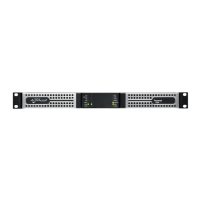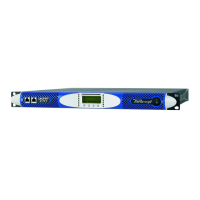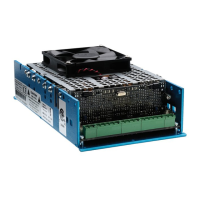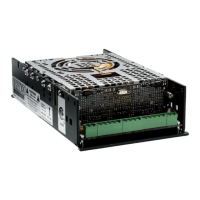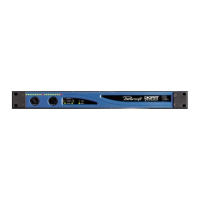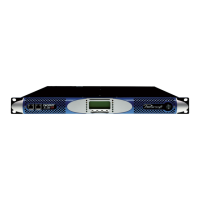▶
25
Duecanali User Guide
Thresh.(Vpk)
ok
fast
- +
169 Vpk
CH1
GR= 0.0dB I= 11.7dBu
FIGURE 39: Peak limiter threshold value editing screen
RMS Limiter
Given the low efciency of electromechanical transducers, almost
50% of power reaching the voice coil is transformed into heat. The
power limiter is intended to avoid melting the voice coils of drivers
while at the same time exploiting their maximum performance. All
the power limiters base their operations on the temporal behavior
of the voltage and the current, this means that the amplier knows
the real amount of real power delivered to the load. A correct
power limiting is not an easy task and is multifaceted, based on
a number of variables, like the knowledge of the component
heat dissipation and the goals that must be achieved. Therefore
it may be difcult and a little bit empirical to decide thresholds
and constants over time. Power limiters behavior base their
operations on a mix based on threshold, temporal behavior of the
output readings (voltage and/or current) and the type of output
readings monitored. The power limiter should be used to protect
the drivers from melting. It should NOT be engaged at normal
working levels. Check the gain reduction: in order to obtain the
optimal sound it should not be greater than 2-4dB even for the
loudest piece of music. Please note that a common musical signal
has very high peaks, but a rather small average level (high crest
factor). A continuous tone has a much higher average power even
if it “sounds” less loud to the human ear. This must be taken into
account while setting up limiter parameters. The power limiter
acts by decreasing the amplier’s gain in order to reduce the
power delivered to the load. There are three main operating
modes for the Duecanali Series power limiters.
TruePower
TM
In the TruePower operating mode, the amplier’s active output
power is estimated by measuring the load current. The TruePower
limiter is a Powersoft patent technology useful to avoid overheating
of the voice coil; it can however also be used to avoid power
compression. The amplier’s DSP provides the measurement of
the real power delivered (and then dissipated) to the coil, not the
apparent power handled by the line.
Empirical observation yields the following equation:
P
AES
P
max diss
=
3
where P
AES
is the declared AES Power and P
max diss
is the maximum
power the speaker can dissipate “in real life”.
If the P
AES
is not available, the P
RMS
(declared maximum RMS power
the loudspeaker can handle) can be used; however, it is important
to proceed with caution in evaluating how the P
RMS
value is
obtained. If no other values are declared, this rule of thumb can
be used: the P
AES
can be estimated as 6dB below the peak power
(¼ of the peak power). It is very important to note that, contrary
to what happens with the peak limiter, setting the TruePower
limiter parameters must take into account the number of speakers
connected to the amplier. This is due to the fact that the real
power is calculated not only with the output voltage (which is
identical for all speakers connected in parallel) but also with the
output current (which changes according to the number of parallel
speakers).
Determining the ideal time parameters for TruePower limiters is a
very empirical process. As a guide, consider this simple rule:
Larger the coil, larger the thermal inertia, larger the time constant.
The following table summarizes this concept with practical
numbers:
Driver voice coil size
(inches) and application
True Power
Threshold
(W)
Attack
time (ms)
Decay
time
(ms)
1” tweeter 10 - 20 100 300
1.5” tweeter 20 - 30 150 300
2” horn driver 20 - 40 200 400
3” horn driver 30 - 50 300 500
4” horn driver 40 - 60 500 3000
2” midrange 30 - 100 500 3000
3” midbass 50 - 150 1000 5000
4” woofer 100 - 200 2000 5000
4” woofer 150 - 250 4000 8000
6” woofer 250 - 500 6000 10000
Power vs V @ 8 Ω
In the Power vs V @ 8 Ohm operating mode, the amplier’s output
power is estimated by measuring the RMS value of the output
voltage, assuming an 8 ohm load. This mode allows to create
settings that work well for any number of speakers connected
in parallel. For example, if a “Power @ 8 Ohm” limiter is set to
limit the output power to 150W, a single cabinet will be delivered
a maximum of 150W with 8 ohm load. Two speaker cabinets
connected in parallel will be delivered a maximum of 300W with
4 ohm load (“ 8 Ohm loads in parallel) and so on.
This limiter is a pure RMS limiter whose functioning is based
solely on the voltage module measured at the amplier output.
Differently from the TruePower limiter, this limiter does not
take into account the real part of the power; however, it has the
advantage of being independent from the number of cabinets
linked together, just as a peak limiter.
Some attention is needed to set the power threshold. The P
AES
can
be used if it is available. If no other power rating is declared, the
P
RMS
can be used; however, the RMS parameter is a value related
to the maximum manageable power and not the real power.
Proceed with caution because the manageable power could be
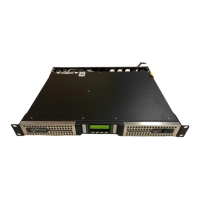
